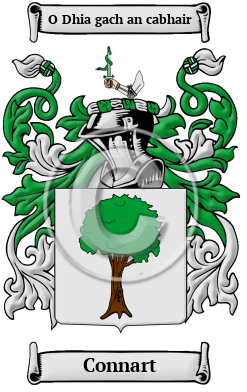| ![Show Contents]() Connart History, Family Crest & Coats of Arms Connart History, Family Crest & Coats of Arms
Etymology of ConnartWhat does the name Connart mean? Today's Irish surnames are underpinned by a multitude of rich histories. The name Connart originally appeared in Gaelic as Ó Conchobhair, derived from the personal name Conchobhar. 1 Early Origins of the Connart familyThe surname Connart was first found in Connacht. There were six different septs of this famous name scattered throughout Ireland, of which four continue to boast many members. However, the most important O'Connors were those of Connacht, divided into three main branches: O'Conor Don; O'Conor Roe; and O'Conor Sligo. The Connacht O'Connors were direct descendants of Conchobhar, King of Connacht, who died in 971 AD. Furthermore, this family produced the last two High Kings of Ireland: Turlough O'Connor (1088-1156) and Roderick O'Connor (1116-1196). It was the invasion of Leinster by Roderick O'Conner on behalf of the Prince of West Brefney that caused the King of Leinster, Dermod MacMorough, to flee to England for aid. This resulted in the Strongbow Invasion of 1168, the beginning of English domination over Ireland. Despite remaining stubbornly Catholic, the O'Connor family continued to maintain their elite position among the Irish nobility throughout the entire period of British dominance. Early History of the Connart familyThis web page shows only a small excerpt of our Connart research. Another 182 words (13 lines of text) covering the years 1002, 1641, 1652, 1666, 1698, 1710, 1763, 1791, 1838, 1852 and 1906 are included under the topic Early Connart History in all our PDF Extended History products and printed products wherever possible. Connart Spelling VariationsMany spelling variations of the surname Connart can be found in the archives. One reason for these variations is that ancient scribes and church officials recorded names as they were pronounced, often resulting in a single person being recorded under several different spellings. The different spellings that were found include Connor, Conner, Conor, Connors, O'Connor, Connores, Conner, Connar, Connars, O'Connar, O'Conner, Connair, Connairs, Connaire, Connaires, Cawner, Cawners, Caunnor, Cauner, Cauners and many more. Early Notables of the Connart familyNotable amongst the family name at this time was Cabrach O'Conor and Hugh O'Connor, son and grandson of O'Conor Don, took a prominent part in the 1641-1652 warsBernard Connor or O'Connor (1666?-1698), Irish physician and historian, descended from an ancient Irish family...
Another 41 words (3 lines of text) are included under the topic Early Connart Notables in all our PDF Extended History products and printed products wherever possible. Migration of the Connart familyIn the 19th century, thousands of Irish left their English-occupied homeland for North America. Like most new world settlers, the Irish initially settled on the eastern shores of the continent but began to move westward with the promise of owning land. The height of this Irish migration came during the Great Potato Famine of the late 1840s. With apparently nothing to lose, Irish people left on ships bound for North America and Australia. Unfortunately a great many of these passengers lost their lives - the only thing many had left - to disease, starvation, and accidents during the long and dangerous journey. Those who did safely arrive in "the land of opportunities" were often used for the hard labor of building railroads, coal mines, bridges, and canals. The Irish were critical to the quick development of the infrastructure of the United States and Canada. Passenger and immigration lists indicate that members of the Connart family came to North America quite early: William Conner who settled in Plymouth, arriving on the "Fortune" in 1621; just a year after the "Mayflower," Cornelious Conner, who settled in Exeter in 1650.
The motto was originally a war cry or slogan. Mottoes first began to be shown with arms in the 14th and 15th centuries, but were not in general use until the 17th century. Thus the oldest coats of arms generally do not include a motto. Mottoes seldom form part of the grant of arms: Under most heraldic authorities, a motto is an optional component of the coat of arms, and can be added to or changed at will; many families have chosen not to display a motto.
Motto: O Dhia gach an cabhair
Motto Translation: From God Every Help
- MacLysaght, Edward, The Surnames of Ireland. Ireland: Irish Academic Press, sixth edition, 1985. Print. (ISBN 0-7165-2366-3)
 |

